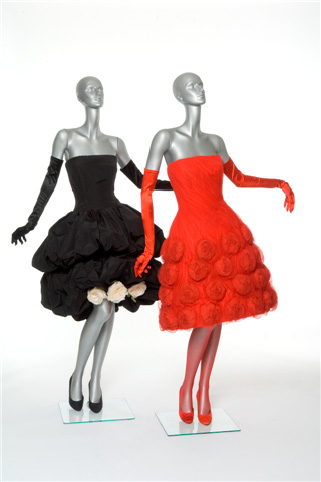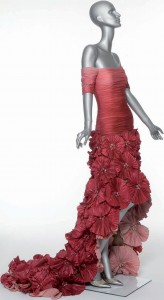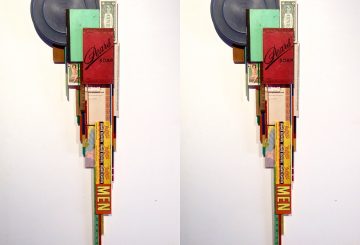Sharne Wolff crosses Brisbane’s bridge of doom to take in the splendor of Valentino and ponder the question that should never be asked of fashion: is it art?
It’s a Tuesday afternoon in Brisbane when I discover that the exhibition I am planning to review for The Art Life is showing at a gallery that keeps Wednesday to Saturday hours. So instead I make a quick decision to try out the new ‘Go Between’ bridge (I’m a fan of the band from way back) and hop over to the Gallery of Modern Art – just a little begrudgingly – to see Valentino Retrospective: Past/Present/Future.
My initial lack of enthusiasm is not because I dislike fashion. It’s just that I’m a little over it after the Easton Pearson exhibition at GOMA at the end of 2009 and the Hats Anthology from London’s Victoria & Albert Museum which only just finished at the Queensland Art Gallery. Plus there’s all the pre-show publicity. If you reside anywhere in South East Queensland you would have to live under a rock not to know about the Valentino show. The advertising has been intense and sustained over the last few months. Last week it got so crazy on Facebook that fans started complaining about the excessive number of posts from the Gallery.
As a result this show is bound to be another GOMA blockbuster like the previous two fashion exhibitions apparently were. It won’t, however, prevent the perennial question about whether fashion belongs in an art gallery, nor criticism of the GOMA’s tendency on occasions to be overly safe and not show enough edgy or experimental work. If, however, the Gallery’s driving philosophy is to ‘connect art and people’ then it is certainly arguable that the GOMA is doing an excellent job.
According to William Hazlitt, nineteenth century English literary critic and essayist, “Fashion is haughty, trifling, affected, servile, despotic, mean and ambitious, precise and fantastical, all in a breath – tied to no rule, and bound to conform to every whim of the minute…”. Critics also argue that fashion represents excess and unworthy motives, that it is anti-feminist, anti-individual and egoistic. On the other hand, it is difficult to maintain that fashion should not be worthy of consideration as art alongside any other visual aesthetic, or that fashion designers who are masters of their trade should not be considered artists in their own right. “Fashion is, after all, a form of visual art, a creation of images with the visual self as its podium,” wrote Elizabeth Wilson in Adorned in Dreams.
Over to Valentino Clemente Ludovico Garavani, born in 1932, apparently named by his mother after Rudolph Valentino. Generally known only by his first name, Valentino is now fully retired having sold the Italian fashion house that bears his name and shown his final haute couture collection in 2008. The GOMA exhibition consists of 100 mannequins, 95 of which are silver and wear haute couture Valentino designs created over a fifty year period from 1959. The other five mannequins wear clothes designed since Valentino’s retirement, allowing the Gallery to show current designs which fit the ‘future’ section of the exhibition.
The show takes up the entire ground floor of the GOMA and at first glance is definitely more reminiscent of something you might encounter in a regular (non-art) museum but without the timber cabinetry. It all looks very modern and slick. Dark grey walls, polished concrete floors and subdued background lighting allow the clothes themselves to present a glorious display of colour in two very large rooms.
The Retrospective is curated according to certain themes which include animal prints, florals, Aztec designs, geometrics, frills, and of course, those based on the famous Valentino colours of red, white and black. In the centre of the two rooms GOMA has set up a ‘Resources Section’ (read loads of fashion magazines and lots of pictures of Valentino hanging out with various celebrities), which includes videos of the clothes on parade, and Valentino at work. This exhibition even has its own coffee shop and special lounge area enabling a relaxing coffee break with view of the river. With a few mags for reading you could easily spend most of the day in here with a few friends.
Back to the fabulous frocks – and there is no denying they are truly stunning. Valentino is quoted as saying that his constant ambition was to “reinvent the ephemeral notion of elegance and to embellish the natural beauty of women”. Apparently the fundamental basis of Valentino’s design was always to balance volume with form. Unlike some fashion seen in magazines and in haute couture parades, the clothes in this exhibition look eminently wearable and I can’t imagine any woman viewing the show and not fantasising about wearing at least one of these creations.
Overall the designs are elegant and graceful, rich, sophisticated and elaborate. Some are also great fun. They all show talented and incredible craftsmanship and attention to detail. The fabrics are beautiful and it seems silk was generally the fabric of choice, although some synthetics were used when the designer required a dress to hold its shape.
Valentino took his inspiration from many sources. An evening gown from the Autumn Winter collection of 1992/93 is in chestnut and bronze silk which has been sequined and gilded with gold circles, and draws its inspiration from the gilded paintings of Paul Klee. Apparently Valentino appropriated his idea for using corals (both the colour and the visuals) from the coral necklace often worn by the Christ child in medieval paintings as a symbol for warding off evil spirits. Most of the florals in the collection take their inspiration from actress Vivien Lee’s character of Scarlett O’Hara in Gone with the Wind.
Valentino’s signature red is a specific mix of red, yellow and black. In other ways the designs for the ‘red collection’ are remarkably restrained. A 1959 red frock worn by Jennifer Anniston in 2004 to one of her movie previews, and the now famous black and white dress worn by Julia Roberts to collect her Oscar in 2001 demonstrates how contemporary Valentino’s designs remain today.
It really would be possible to write an entire essay on each and every one of these designs and… you guessed it, there really isn’t a lot not to like about this exhibition. But we still haven’t answered the question…is it art?
To settle the issue once and for all I decided to turn to modern technology. I asked my new iphone App of the same name to determine whether the pink ‘Evening Ensemble’ (from the Autumn Winter collection of 2007/2008) used in all the advertising for the exhibition is Art. The answer came back within a few seconds: “This piece is modernist after modernism without being post modernist. Therefore THIS IS ART”.




Pingback: Tweets that mention Valentino: pants? | The Art Life -- Topsy.com